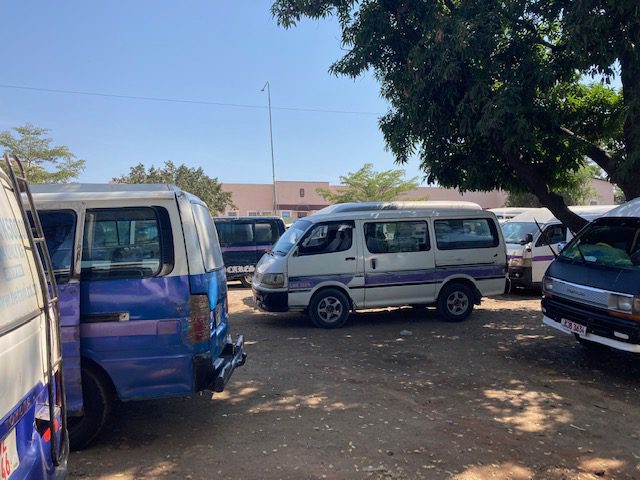Getting into Zambia from Botswana by public transport
I came into Zambia from Botswana over the Kazungula border. To go to the Kazungula border post from the Botswana side, you can take a taxi at the Choppies taxi rank. It should be around 100 pula (~7€). Taxis need a special permit to cross the bridge, that’s why it is more expensive. I just walked along the road in the direction of the bridge and flagged down a taxi that was already half full. I asked the driver to drop me at the bridge and paid 20 pula (~1,4€) for the ride to the bridge. I then walked over the bridge, which was very nice. A few taxi drivers offered me a ride, also going to Livingstone and told me to find them at the border, as I refused to get in because I wanted to walk. It is quite scenic over the Chobe river, with Botswana and Zimbabwe behind you, Namibia to the left, and Zambia in front of you. At the border, I had to go to the medical station first where I got my temperature measured and then proceeded to get the stamps in the main building. It was very straightforward and easy. This border is known to be very difficult when travelling by car, but by foot it couldn’t be easier. There is an ATM and money exchange at the border as well. I couldn’t find any Kwacha in Botswana, but turns out Pula are rather precious in Zambia and they will gladly take them in exchange for Kwacha. There was a bureau de change and ATM at the border. From the border you can take any taxi to go to the ‘Livingstone station’, which is a market place in Kazungula where you can get a SIM card and food as well. It’s about a five minute drive away from the border post, so you can also walk that bit. The taxi from Kazungula to Livingstone was 80 Kwacha (~4€) per person.
Victoria Falls by public transport
There is no information on this online, or at least I couldn’t find any, but it is perfectly possible to go to the Victoria Falls by public transport from Livingstone. The distance is even walkable if you like, but because of elephants on the route it is not necessarily advisable. To get on a minibus towards the Victoria Falls, go to the minibus rank at the City Market and ask for the minibus ‘to the Falls’. Many local people go there to sell clothes on the Zimbabwean side or buy cooking oil there and sell it back in Zambia, so the minibus fills up quickly. The fare was 10 Kwacha (~0,5€). When you arrive at the station near the Victoria Falls, just follow the vendors and you’ll find your way to the bridge as well as to the Victoria Falls park gate. It’s not far. I went onto the bridge first and I would definitely recommend that. The view is quiet nice from up there. You just need to show your passport to the border guard and tell them you want to go to the bridge only. They’ll give you a little paper with a stamp that you have to hand in before the gate and you can go until the Zimbabwe side (but not cross into Zimbabwe). Going back it’s the same process.
Inner-city transport in Zambia
The minibuses are pretty much the same as in all the other countries in southern Africa that I have covered before. The only difference I noticed is that the conductors lean out the window to whistle to let potential passengers know that there is still space. To flag a minibus down, just wave your stretched arm at the approaching bus and hop in. Paying the fare works in the same way as well: just hand the money towards the conductor and they will hand you back your change. There are no tickets or registration sheets for travelling within the city and it is very cheap, 6 Kwacha (~0,3€) for a trip within Livingstone for example. The more expensive option is taking a taxi. I had to resort to that option once or twice when it had already gotten dark. By night, the minibuses become very infrequent, so it’s easiest to get a taxi. The same trip I did for 6 Kwacha on a minibus cost 50 Kwacha (~2,5€) with a taxi. You can pay taxis either by cash or in mobile money, which is very common. You can get mobile money by buying airtime at one of the many Airtel/MTN booths.
Inter-city transport in Zambia
There are plenty of minibuses and big buses connecting Livingstone and Lusaka for example. The buses are between 300 and 350 Kwacha (~15-17,5€) and leave in regular intervals every morning. You can just check at the bus station opposite Choppies in Livingstone. I took the bus to go from Lusaka to Kapiri Mposhi on a big bus and paid 260 Kwacha (~13€). It took almost 7 hours to do the trip, so I am pretty sure there must be better bus or minibus options. You can check them out at the Inter-city bus station in Lusaka.
Getting around Lusaka
While there is a network of minibuses in Lusaka, I found the easiest and most cost-effective option to travel around Lusaka to be Yango. It’s like Uber. You can pay in cash or mobile money and it is really cheap. A trip of about 5 minutes will cost you about 20 Kwacha (~1€). You can download the app in the Playstore/Appstore and it works really well. The driver will call you once you’ve requested the ride to ask you where you are and where you are going and then it works like Uber really.
Travelling by train in Zambia
While there are train tracks all over southern Africa, there are currently almost no trains actually going places, with one exception: Zambia! This got me very excited because after spending five months travelling by bus and minibus, I was ready for a change. Basically there are two train lines in Zambia: one from Livingstone to Kitwe and one from Kapiri Mposhi to Dar es Salaam in Tanzania. The latter is called the Tazara train, you can check out my blog post about it here. The train going from Livingstone to Kitwe leaves every Monday at 20:00 from Livingstone. You can buy your ticket from 14:00 at the Livingstone station. I was there at 14:00 and in the end I could only buy my ticket at 15:30 because the person who sells them ‘was at the bank’. I initially wanted to buy a first class sleeper ticket, but was told that the first class wagon was not running that week, so I settled for a second class sleeper ticket (which is only 20 Kwacha less, i.e. 240 Kwacha, so ~12€). That gives you a bed (no linen) in a three-bed cabin that you can lock from the inside. There is a little sink in the cabin, but there was no water. The train left at 20:00. It is very slow and rather run down. There was no water in the flushing toilets, many windows were broken, the wagons shake a lot on the old tracks and the train stops a lot in the middle of nowhere for no apparent reason. Sometimes you can buy fruit or baked goods through the windows. I enjoyed the experience a lot. The journey took exactly 24 hours, just 4 hours longer than foreseen. Going by bus is a lot faster, so if you are in a hurry, do not take the train.

